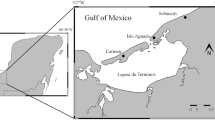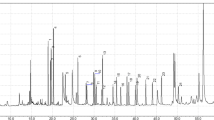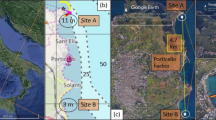Abstract
We have studied the breeding parameters, organochlorine compounds (OCs) concentrations, and fatty acid (FA) composition of egg yolks (n = 47) and plasma (n = 90) of common terns (Sterna hirundo) from two colonies (Banya and Fangar) in the Ebro delta, NE Spain. Terns from Banya tend to have smaller clutch size and lower hatching success than terns from Fangar. p,p'-DDE and polychlorinated biphenyls (PCBs) concentrations were almost 2-fold higher in yolks from Banya in 1998 than from Fangar in 1999, and the percentage of n−6 PUFA was positively correlated with these contaminants. Differences between samplings in OCs concentrations in plasma were less evident, and were affected by breeding chronology. The highest OCs concentrations in yolks from Banya may be explained by two processes involving the increased deposition of n−6 PUFA: (1) higher mobilization of endogenous fat due to lower food resources, or (2) differences in the diet between colonies. Birds from Banya may have been feeding at a higher degree on discards of trawling fisheries composed of demersal and benthic fish species that are more exposed to contaminants from sediment and have lower n−3/n−6 ratio, whereas birds from Fangar would feed mostly on pelagic species of small clupeiformes that are less polluted and have higher n−3/n−6 ratios.
Similar content being viewed by others
References
Aitchison J. (1986). The Statistical Analysis of Compositional Data. London, UK: Chapman and Hall.
Albaigeés, J., Farrán, A., Soler, M., Gallifa, A. and Martin, P. (1987). Accumulation and distribution of biogenic and pollutant hydrocarbons, PCBs and DDT in tissues of Western Mediterranean fishes. Mar. Environ. Res. 22, 1–18.
Arcos, J.M. (2001). Foraging ecology of seabirds at sea: significance of commercial fisheries in the NW Mediterranean. PhD Thesis. Universitat de Barcelona.
Arcos, J.M., Ruiz, X., Bearhop, S. and Furness, R.W. (2002). Mercury levels in seabirds and their fish prey at the Ebro Delta (NW Mediterranean): the role of trawler discards as a source of contamination. Mar. Ecol. Prog. Ser. 232, 281–90.
Becker, P.H., Schuhmann, S. and Koepff, C. (1993). Hatching failure in common terns (Sterna hirundo) in relation to environmental chemicals. Environ. Pollut. 79, 207–13.
Bosveld, A.T.C., Gradener, J., Murk, A.J., Brower, A., van Kampen, M., Evers, E.H.G. and Van den Berg, M. (1995). Effects of PCDDs, PCDFs and PCBs in common tern (Sterna hirundo) breeding in estuarine and coastal colonies in the Netherlands and Belgium. Environ. Toxicol. Chem. 14, 99–115.
Bustnes, J.O., Erikstad, K.E., Bakken, V., Mehlum, F. and Skaare, J.U. (2000). Feeding ecology and the concentration of organochlorines in glaucous gulls. Ecotoxicology 9, 179–86.
Cherian, G., Wolfe, F.W. and Sim, J.S. (1996). Dietary oils with added tocopherols: effects on egg or tissue tocopherols, fatty acids, and oxidative stability. Poultry Sci. 75, 423–31.
Corominas, R. (1998). Determinació d'àcids grassos i de residus organoclorats en fetge de làrids, estèrnids i limícoles. BSc Thesis. Bellaterra: Universitat Autònoma de Barcelona.
D.A.R.P. (1998). Estadístiques agràries i pesqueres-1998. Barcelona, Spain: Departament d'Agricultura, Ramaderia i Pesca, Generalitat de Catalunya.
D.A.R.P. (1999). Estadístiques agràries i pesqueres-1999. Barcelona, Spain: Departament d'Agricultura, Ramaderia i Pesca, Generalitat de Catalunya.
Drouillard, K.G. and Norstrom, R.J. (2001). Quantifying maternal and dietary sources of 2,2',4,4',5,5'-hexachlorobiphenyl deposited in eggs of the ring dove (Streptopelia risoria). Environ. Toxicol. Chem. 20, 561–7.
Fasola, M., Vecchio, I., Caccialanza, G., Gandini, C. and Kitsos, M. (1987). Trends of organochlorine residues in eggs of birds from Italy, 1977 to 1985. environ. Pollut. 48, 25–36.
Fox, G.A. (1976). Eggshell quality: Its ecological and physiological significance in a DDE-contaminated common tern population. Wilson Bull. 88, 459–77.
Gilbertson, M., Kubiak, T., Ludwig, J. and Fox, G. (1991). Great Lakes embryo mortality, edema, and deformities syndrome (GLEMEDS) in colonial fish-eating birds: similarity to chick-edema disease. J. Toxicol. Environ. Health 33, 455–520.
Grasman, K.A. and Fox, G.A. (2001). Associations between altered immume function and organochlorine contamination in young Caspina terns (Sterna caspia) from Lake Huron, 1997-1999. Ecotoxicology 10, 101–114.
Guitart, R., Guerrero, X., Silvestre, A.M., Gutiérrez, J.M. and Mateo, R. (1996). Organochlorine residues in tissues of striped dolphins affected by the 1990 Mediterranean epizootic: relationship with the fatty acid composition. Arch. Environ. Contam. Toxicol. 30, 79–83.
Guitart, R., Martínez-Silvestre, A., Guerrero, X. and Mateo, R. (1999). Comparative study on the fatty acid composition of two marine vertebrates: striped dolphins and loggerhead turtles. Comp. Biochem. Physiol. B 124, 439–43.
Guitart R., Mateo R., Sanpera C., Hernández-Matáas A. and Ruiz X. (2003). Mercury and selenium levels in eggs of common terns (Sterna hirundo ) from two breeding colonies in the Ebro delta, Spain. Bull. Environ. Contam. Toxicol. 70, 71–7.
Guitart, R., Puig, P. and Gómez-Catalán, J. (1993). Requirement for a standardized nomenclature criterium for PCBs computer assisted assignment of correct congener denomination and numbering. Chemosphere 27, 1451–9.
Gutiérrez, J.M., Mateo, R., Prats, C. and Guitart, R. (1997). Organochlorine residues in normal and lead poisoned greater flamingos: relationships with the fatty acid composition. J. Environ. Sci. Health A 32, 853–63.
Harbige, L.S., Ghebremeskel, K., Williams, G. and Crawford, M.A. (1992). Hepatic fatty acids in wild rockhopper (Eudyptes crestatus) and Magellanic (Spheniscus magellanicus) penguins before and after mouting. Zool. Sci. 9, 315–20.
Harris, H.J., Erdman, T.C., Ankley, G.T. and Lodge, K.B. (1993). Measures of reproductive success and polychlorinated biphenyls residues in eggs and chicks of Foster's terns on Green Bay, Lake Michigan, Wisconsin-1988. Arch. Environ. Contam. Toxicol. 25, 304–14.
Hebert, C.E., Shutt, J.L. and Norstrom, R.J. (1997). Dietary changes cause temporal fluctuations in polychlorinated biphenyl levels in herring gull eggs from Lake Ontario. Environ. Sci. Technol. 31, 1012–7.
Hoffman D.J., Rice, C.P. and Kubiak, T.J. (1996). PCBs and dioxins in birds. In W.N. Beyer, G.H. Heinz and A.W. Redmon-Norwod (eds). Environmental Contaminants in Wildlife. Interpreting Tissue Concentrations, pp. 165–207. Boca Raton, FL: Lewis Publishers.
Hoffman, D.J., Smith, G.J. and Rattner, B.A. (1993). Biomarkers of contaminant exposure in common terns and black-crowned night herons in the Great Lakes. Environ. Toxicol. Chem.12, 1095–103.
Iverson, S.J., Frost, K.J. and Lowry, L.F. (1997). Fatty acid signatures reveal fine scale structure of foraging distribution of harbor seals and their prey in Prince William Sound, Alaska. Mar. Ecol. Prog. Ser. 151, 255–71.
Kubiak, T.J., Harris, H.J., Smith, L.M., Schwartz, T.R., Stalling D.L., Trick, J.A., Sileo, L., Docherty, D.E. and Erdman, T.C. (1989). Microcontaminants and reproductive impairement of the Forster's tern on Green Bay, Lake Michigan-1983. Arch. Environ. Contam. Toxicol. 18, 706–27.
Lorenzen, A., Shutt, J.L. and Kennedy, S.W. (1997). Sensitivity of common tern (Sterna hirundo) embryo hepatocyte cultures to CYP1A induction and porphyrin accumulation by halogenated aromatic hydrocarbons and common tern egg extracts. Arch. Environ. Contam. Toxicol. 32, 126–34.
Maldonado, A. (1977). Introducción geológica al delta del Ebro. Treb. Inst. Cat. Hist. Nat. 8, 7–45.
Mañosa, S., Mateo, R. and Guitart, R. (2001). A review of the effects of agricultural and industrial contamination on the Ebro delta biota and wildlife. Environ. Monit. Assess. 71, 187–205.
Mateo, R., Gámez, A. and Guitart, R. (1998). Organochlorine residues in hunted wild mallards in the Ebro delta, Spain. Bull. Environ. Contam. Toxicol. 60, 134–41.
Montalbetti-Aguirre, G.M. (1999). Paràmetros oológicos del charràn común (Sterna hirundo) nidificante en el delta del Ebro. Master's Degree Thesis. Barcelona: Universitat de Barcelona.
Mora, M.A., Auman, H.J., Ludwig J.P., Giesy, J.P., Verbrugge, D.A. and Ludwig, M.E. (1993). Polychlorinated biphenyls and chlorinated insecticides in plasma of Caspian terns: relationships with age, productivity, and colony site tenacity in the Great Lakes. Arch. Environ. Contam. Toxicol. 24, 320–31.
Murk, A.J., Boudewijn, T.J., Meininger, P.L., Bosveld, A.T.C., Rossaert, G., Ysebaert, T., Meire, P. and Dirksen, S. (1996). Effects of polyhalogenated aromatic hydrocarbons and related contaminants on common tern reproduction: integration of biological, biochemical, and chemical data. Arch. Environ. Contam. Toxicol. 31, 128–40.
Niemi, G.J., Davis, T.E., Veith, G.D. and Vieux, B. (1986). Organochlorine chemical residues in herring gulls, ring-billed gulls, and common terns of Western Lake Superior. Arch. Environ. Contam. Toxicol. 15, 313–20.
Oro, D., Bosch, M. and Ruiz, X. (1995). Effects of trawling fisheries moratorium on the breeding success of the yellowlegged gull Larus cachinnans. Ibis 137, 547–9.
Oro, D., Jover, L. and Ruiz, X. (1996). The effects of a trawling moratorium on the breeding ecology of a threatened seabird, Audouin's Gull Larus audouinii. Mar. Ecol. Prog. Ser. 139, 1929.
Pastor, D., Jover, L., Ruiz, X. and Albaigés, J. (1995). Monitoring organochlorine pollution in Audouin's gull eggs: the relevance of sampling procedures. Sci. Total Environ. 162, 215–23.
Porte, C. and Albaigés, J. (1993). Bioaccumulation patterns of hydrocarbons and polychlorinated biphenyls in bivalves, crustaceans, and fishes. Arch. Environ. Contam. Toxicol. 26, 273–81.
Sagerup, K., Henriksen, E.O., Skaaren, J.U. and Gabrilesen, G.W. (2002). Intraspecific variation in trophic feeding levels and organochlorine concentrations in glaucous gulls (Larus hyperboreus) from Bjørnøya, the Barents Sea. Ecotoxicology 11, 119–25.
Saglik, S. and Imre, S. (2001). ω3-fatty acids in some fish species from Turkey. J. Food Sci. 66, 210–2.
Schulz, D.E., Petrick, G. and Duinker, J.C. (1989). Complete characterization of polychlorinated biphenyl congeners in commercial Aroclor and Clophen mixtures by multidimensional gas chromatography-electron capture detection. Environ. Sci. Technol. 23, 852–9.
Tanakol, R., Yazici, Z., Şener, E. and Sencer, E. (1999). Fatty acid composition of 19 species of fish from the Black Sea and the Marmara Sea. Lipids 34, 291–7.
Tornaritis, M., Paraki, E., Georgulli, M., Kafatos, A., Charalambakis, G., Divanack, P., Kentouri, M., Yiannopoulos, S., Frenaritou, H. and Argyrides, R. (1993). Fatty acid composition and total fat content of eight species of Mediterranean fish. Int. J. Food Sci. Nutr. 45, 135–9.
Walker, C.H. (1990). Persistent pollutants in fish-eating sea birds-bioaccumulation, metabolism and effects. Aquat. Toxicol. 17, 293–324.
Weseloh, D.V., Custer, T.W. and Braune, B.M. (1989). Organochlorine contaminants in eggs of common terns from the Canadian Great Lakes, 1981. Environ. Pollut. 59, 141–60.
Wiemeyer, S.N. (1996). Other organochlorine pesticides. In W.N. Beyer, G.H. Heinz and A.W. Redmon-Norwod (eds). Environmental Contaminants in Wildlife. Interpreting Tissue Concentrations, pp. 99–115. Boca Raton, FL: Lewis Publishers.
Yamashita, N., Tanabe, S., Ludwig, J.P., Kurita, H., Ludwig, M.E. and Tatsukawa, R. (1993). Embryonic abnormalities and organochlorine contamination in double-crested cormorants (Phalacrocorax auritus) and Caspian terns (Hydroprogne caspia) from the upper Great Lakes in 1988. Environ. Pollut. 79, 163–73.
Author information
Authors and Affiliations
Rights and permissions
About this article
Cite this article
Mateo, R., Gil, C., Badia-Vila, M. et al. Use of Fatty Acids to Explain Variability of Organochlorine Concentrations in Eggs and Plasma of Common Terns (Sterna hirundo). Ecotoxicology 13, 545–554 (2004). https://doi.org/10.1023/B:ECTX.0000037191.98464.44
Issue Date:
DOI: https://doi.org/10.1023/B:ECTX.0000037191.98464.44




